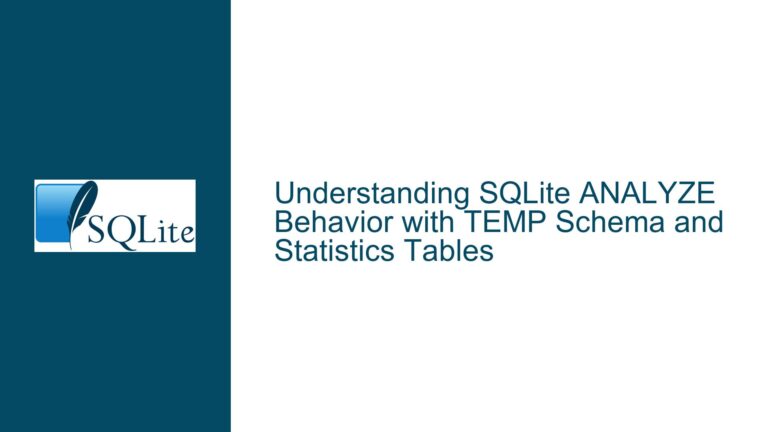Inconsistent Constraint Reporting in xBestIndex for SQLite Virtual Tables
Issue Overview: xBestIndex Fails to Report All Constraints on Hidden Columns in Non-JOIN Queries
The core issue revolves around the behavior of the xBestIndex method in SQLite’s virtual table implementation, specifically when dealing with hidden columns. Hidden columns in SQLite are columns that are not visible in a SELECT * query but can still be used in queries if explicitly referenced. The problem arises when a query involves constraints on hidden columns, particularly when one hidden column is constrained to another hidden column, and the query does not involve JOIN operations.
In the provided examples, the virtual table vtab is defined with two hidden columns, foo and bar, and two visible columns, x and y. The issue manifests in queries where foo and bar are constrained in a non-JOIN context. For instance, in the query SELECT * FROM vtab WHERE foo = ? AND bar = foo;, the xBestIndex method fails to report constraints on bar, even though it correctly reports constraints on foo. This inconsistency is not observed when the query involves a JOIN, as seen in the query SELECT vtab.* FROM vtab, other_table WHERE foo = ? AND bar = foo;, where xBestIndex correctly reports constraints on both foo and bar.
The inconsistency in constraint reporting can lead to suboptimal query plans, as the virtual table implementation may not be aware of all the constraints that could be used to optimize the query. This issue is particularly problematic for developers who rely on the xBestIndex method to determine the best way to access the virtual table’s data, as it can result in unexpected behavior and performance degradation.
Possible Causes: Transitive Constraint Logic and JOIN Context Sensitivity
The root cause of this issue appears to be related to how SQLite handles transitive constraints and the context in which these constraints are applied. In SQLite, a transitive constraint occurs when the value of one column is determined by the value of another column. For example, if foo = ? and bar = foo, then it logically follows that bar = ?. This transitive logic is used by SQLite to infer additional constraints that can be used to optimize queries.
However, this transitive logic seems to be context-sensitive, particularly with respect to whether the query involves a JOIN operation. In queries that involve JOINs, SQLite appears to be more aggressive in applying transitive constraints, resulting in the correct reporting of constraints on both foo and bar. In contrast, in non-JOIN queries, SQLite fails to apply the same transitive logic, leading to the omission of constraints on bar.
Another possible cause is the way SQLite handles hidden columns in the xBestIndex method. Hidden columns are not directly visible in the query results, but they can still be used in constraints. It is possible that the logic for handling hidden columns in xBestIndex is not fully accounting for the transitive relationships between hidden columns, especially in non-JOIN contexts. This could explain why the constraints on bar are not reported in the non-JOIN query, even though they are correctly reported in the JOIN query.
Additionally, there may be an issue with how SQLite determines whether a constraint can be used by the virtual table. For a constraint to be usable by the virtual table, one side of the constraint must be a virtual table column, and the other side must be a value that is available before the virtual table scan begins. In the case of bar = foo, both sides of the constraint are columns of the virtual table, and neither is available before the scan begins. This could lead SQLite to conclude that the constraint is not usable by the virtual table, resulting in the omission of the constraint in the xBestIndex output.
Troubleshooting Steps, Solutions & Fixes: Ensuring Consistent Constraint Reporting in xBestIndex
To address the issue of inconsistent constraint reporting in xBestIndex, developers can take several steps to ensure that all constraints are correctly reported, regardless of whether the query involves a JOIN operation. The following troubleshooting steps and solutions can help resolve the issue:
Update to the Latest SQLite Version: The first and most straightforward solution is to update to the latest version of SQLite. As indicated in the discussion, the issue was addressed in a recent check-in (cf63abbe559d04f9). Updating to this version or later should resolve the inconsistency in constraint reporting. Developers should verify that their SQLite installation is up-to-date and that the fix has been applied.
Review and Modify Virtual Table Implementation: If updating SQLite is not an option, developers can review and modify their virtual table implementation to ensure that all constraints are correctly reported in
xBestIndex. This may involve explicitly handling transitive constraints in thexBestIndexmethod, especially for hidden columns. Developers should ensure that the logic for handling hidden columns accounts for transitive relationships between columns, regardless of whether the query involves aJOIN.Explicitly Handle Transitive Constraints: Developers can explicitly handle transitive constraints in their virtual table implementation. This involves checking for constraints where one column is constrained to another column and inferring additional constraints based on these relationships. For example, if
foo = ?andbar = foo, the implementation should infer thatbar = ?and report this constraint inxBestIndex. This approach ensures that all relevant constraints are reported, even in non-JOIN queries.Test with Different Query Structures: Developers should test their virtual table implementation with a variety of query structures, including both JOIN and non-JOIN queries, to ensure that constraints are consistently reported. This testing should include queries with hidden columns and queries where one hidden column is constrained to another. By testing with different query structures, developers can identify any remaining inconsistencies and address them in their implementation.
Use Debugging Tools to Inspect xBestIndex Output: Developers can use debugging tools to inspect the output of
xBestIndexand verify that all constraints are being reported correctly. This may involve adding logging or debugging statements to thexBestIndexmethod to output the constraints that are being reported. By inspecting this output, developers can identify any missing constraints and adjust their implementation accordingly.Consult SQLite Documentation and Community: If the issue persists, developers should consult the SQLite documentation and community for additional guidance. The SQLite documentation provides detailed information on virtual table implementation and the
xBestIndexmethod. Additionally, the SQLite community, including forums and mailing lists, can be a valuable resource for troubleshooting and resolving issues related to virtual tables and constraint reporting.Consider Alternative Database Solutions: In some cases, it may be necessary to consider alternative database solutions if the issue cannot be resolved within SQLite. Developers should evaluate whether another lightweight database, such as PostgreSQL or MySQL, might better meet their needs. However, this should be a last resort, as SQLite is generally well-suited for many use cases, and the issue described here is likely to be resolved in future updates.
By following these troubleshooting steps and solutions, developers can ensure that constraints are consistently reported in xBestIndex, leading to more accurate query plans and better performance for their virtual table implementations. The key is to understand the underlying causes of the issue and to take a proactive approach to addressing them, whether through updates, modifications to the virtual table implementation, or thorough testing and debugging.
In conclusion, the issue of inconsistent constraint reporting in xBestIndex for SQLite virtual tables is a nuanced problem that requires a deep understanding of SQLite’s internal logic and the behavior of hidden columns. By carefully analyzing the issue, understanding its root causes, and applying the appropriate troubleshooting steps and solutions, developers can ensure that their virtual table implementations are robust, reliable, and performant.






